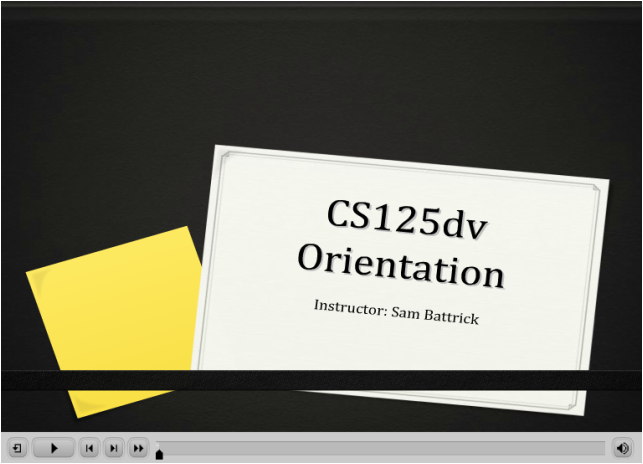Digital Video COURSE
CS125dv: Introduction to Digital Video
This virtual tour of my Digital Video course demonstrates a variety of assessment types and learning modules -- each highlighted by the NETS-T standards to which they align.
Vegas Course Overview from Sam Battrick on Vimeo.
Pan-and-Scan Video Learning Object
NETS-T: Standard 1b: Engage students in exploring real-world issues and solving authentic problems using digital tools and resources.
This video artifact uses a shoebox to replicate the “pan and scan” cameras used by video editors to frame a scene. By using a low tech metaphor for high-tech problems, this video demonstrates to students (who may not yet have any knowledge of the topic) how simple the concept can be represented, before they have to apply the skills digitally.
This video artifact uses a shoebox to replicate the “pan and scan” cameras used by video editors to frame a scene. By using a low tech metaphor for high-tech problems, this video demonstrates to students (who may not yet have any knowledge of the topic) how simple the concept can be represented, before they have to apply the skills digitally.
Pan and Scan Shoebox from Sam Battrick on Vimeo.
Da vinci Panned & Scanned
NETS-T: Standard 1b: Engage students in exploring real-world issues and solving authentic problems using digital tools and resources.
This digital video explains the real-world editing problem of changing aspect ratios by using the visual metaphor of Leonardo Da Vinci’s “The Last Supper” being “cropped” to fit the aspect ratio of a photo frame. Even novice digital video students with no reference point in the software application will still understand the importance of selecting the right sized frame for their photographs.
This digital video explains the real-world editing problem of changing aspect ratios by using the visual metaphor of Leonardo Da Vinci’s “The Last Supper” being “cropped” to fit the aspect ratio of a photo frame. Even novice digital video students with no reference point in the software application will still understand the importance of selecting the right sized frame for their photographs.
CS125dv Online Orientation
NETS-T: Standard 3c: Communicate relevant information and ideas effectively to students, parents, and peers using a variety of digital age media and formats.
This online orientation communicates time-sensitive and relevant information to new online students by dispensing it using a variety of digital media. As opposed to a traditional syllabus, this course orientation and introduction communicates information via audio, text and digital images, and does so concisely, in order to reach a variety of learning styles efficiently.
http://distance.roguecc.edu/videos/course/CS125dv_Orientation_SBattrick/CS125dv_Orientation_SBattrick.htm
This online orientation communicates time-sensitive and relevant information to new online students by dispensing it using a variety of digital media. As opposed to a traditional syllabus, this course orientation and introduction communicates information via audio, text and digital images, and does so concisely, in order to reach a variety of learning styles efficiently.
http://distance.roguecc.edu/videos/course/CS125dv_Orientation_SBattrick/CS125dv_Orientation_SBattrick.htm
Digital Video Lesson Plan: Recreate a Movie Scene
NETS-T: Standard 2a: Design or adapt relevant learning experiences that incorporate digital tools and resources to promote student learning and creativity.
This lesson was created to allow video editing students to practice role playing in a group environment, with the end result being the recreation of a movie scene. Each student plays a specific role, camera operator, editor, composer, etc. using the digital tools and camera found on the iPad. By promoting creativity and collaboration, this lesson creates a learning experience very similar to that found in the video production workplace; students need to work together with digital tools to achieve their goals, or the project will not succeed.
This lesson was created to allow video editing students to practice role playing in a group environment, with the end result being the recreation of a movie scene. Each student plays a specific role, camera operator, editor, composer, etc. using the digital tools and camera found on the iPad. By promoting creativity and collaboration, this lesson creates a learning experience very similar to that found in the video production workplace; students need to work together with digital tools to achieve their goals, or the project will not succeed.
Copyright Information
Please enjoy these examples of my best work as they relate to the ISTE’s NETS for Teachers (NETS•T) standards found here:
http://www.iste.org/standards/nets-for-teachers
Permission to use the standards was kindly granted by Tina Wells of the ISTE on July 26, 2013 -- (see attached email)
http://www.iste.org/standards/nets-for-teachers
Permission to use the standards was kindly granted by Tina Wells of the ISTE on July 26, 2013 -- (see attached email)

